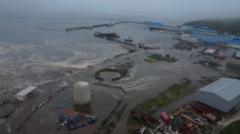Western officials are increasingly alarmed by the potential for sabotage from Russia's shadow fleet, a group of vessels used to evade sanctions. Recent incidents involving the oil tanker Eagle S suggest a troubling escalation in the Kremlin's tactics, heightening security concerns across Europe.
Shadow Fleet Emerges as New Threat in Russia-Ukraine Conflict

Shadow Fleet Emerges as New Threat in Russia-Ukraine Conflict
Concerns grow over Russia's covert naval operations as a tanker linked to its shadow fleet is implicated in sabotaging undersea cables in the Baltic Sea.
In a concerning development for European security, Russian naval operations are being scrutinized amid suspicions of sabotage linked to its shadow fleet. This fleet, comprising a network of aged tankers, was initially created to discreetly transport Russian crude oil while evading sanctions following the invasion of Ukraine. However, recent actions have raised alarms about the potential for more aggressive tactics.
This week, Finnish commandos boarded the oil tanker Eagle S, believed to be responsible for the severing of crucial underwater cables in the Baltic Sea that connect Finland and Estonia. The incident marks a significant escalation and suggests that Russia may be willing to use its covert naval operations to directly target essential infrastructure in Europe. Experts and officials note that if this vessel is confirmed to be involved, it would represent a dangerous turn in Russia’s approach to hybrid warfare against NATO and EU members.
Estonia's interior minister, Lauri Läänemets, emphasized the need for acknowledging the reality of these threats, stating, “We know that Russia is systematically conducting hybrid warfare against its neighboring NATO/EU countries.” In response to this precarious situation, several Baltic Sea nations have ramped up naval and coast guard resources. NATO’s secretary-general, Mark Rutte, affirmed the alliance's commitment to enhancing military presence in the region, further underscoring the significant geopolitical tensions at play.
The implications of Russia's shadow fleet and its potential use in sabotage operations could significantly reshape the security environment in Europe, compelling a reevaluation of strategies among member states to safeguard critical infrastructure against such hybrid threats.
This week, Finnish commandos boarded the oil tanker Eagle S, believed to be responsible for the severing of crucial underwater cables in the Baltic Sea that connect Finland and Estonia. The incident marks a significant escalation and suggests that Russia may be willing to use its covert naval operations to directly target essential infrastructure in Europe. Experts and officials note that if this vessel is confirmed to be involved, it would represent a dangerous turn in Russia’s approach to hybrid warfare against NATO and EU members.
Estonia's interior minister, Lauri Läänemets, emphasized the need for acknowledging the reality of these threats, stating, “We know that Russia is systematically conducting hybrid warfare against its neighboring NATO/EU countries.” In response to this precarious situation, several Baltic Sea nations have ramped up naval and coast guard resources. NATO’s secretary-general, Mark Rutte, affirmed the alliance's commitment to enhancing military presence in the region, further underscoring the significant geopolitical tensions at play.
The implications of Russia's shadow fleet and its potential use in sabotage operations could significantly reshape the security environment in Europe, compelling a reevaluation of strategies among member states to safeguard critical infrastructure against such hybrid threats.




















